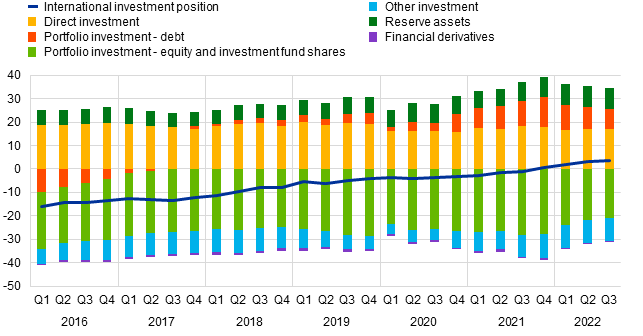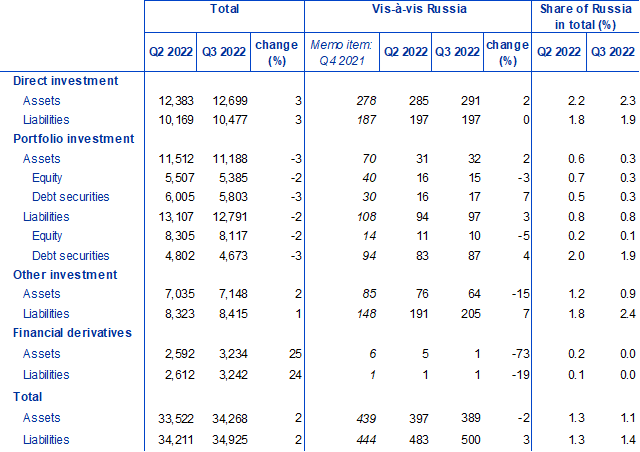- STATISTICAL RELEASE
Euro area quarterly balance of payments and international investment position:
third quarter of 2022
11 January 2023
- Current account deficit at €88 billion (0.7% of euro area GDP) in four quarters to third quarter of 2022, down from €342 billion surplus (2.8% of GDP) a year earlier
- Geographic counterparts: largest bilateral current account deficits vis-à-vis China (€157 billion) and Russia (€83 billion) and largest surpluses vis-à-vis United Kingdom (€144 billion) and Switzerland (€64 billion)
- International investment position showed net assets of €479 billion (3.7% of euro area GDP) at end of third quarter of 2022
- Euro area financial assets vis-à-vis Russia amounted to €389 billion (1.1% of euro area external assets) at end of third quarter of 2022, down by 2% since the end of previous quarter
Current account
The current account of the euro area recorded a deficit of €88 billion (0.7% of euro area GDP) in the four quarters to the third quarter of 2022, after recording a surplus of €342 billion (2.8% of GDP) a year earlier (Table 1). This change was driven by a switch in the goods balance from a surplus of €366 billion to a deficit of €38 billion and, to a lesser extent, by a reduction in the surplus for primary income (down from €64 billion to €7 billion). These developments were partly offset by a larger surplus for services (up from €77 billion to €105 billion) and a smaller deficit for secondary income (down from €165 billion to €162 billion).
The larger surplus for services was mainly due to increases in the surpluses for travel services (from €13 billion to €46 billion), telecommunication, computer and information services (from €121 billion to €144 billion) and transport services (from €9 billion to €25 billion), while larger deficits were recorded for other business services (from €43 billion to €80 billion) and other services (from €30 billion to €39 billion).
The decrease in the primary income surplus was mainly due to a larger deficit in portfolio equity income (increasing from €63 billion to €95 billion), a lower surplus in direct investment income (from €34 billion to €15 billion) and a switch in the other primary income balance from a surplus of €9 billion to a deficit of €0.3 billion, the latter mostly related to an increase in payments to the EU institutions.
Table 1
Current account of the euro area

Source: ECB.
Notes: “Equity” comprises equity and investment fund shares. Discrepancies between totals and their components may arise from rounding.
Data on the geographic counterparts of the euro area current account (Chart 1) show that, in the four quarters to the third quarter of 2022, the euro area recorded its largest bilateral deficits vis-à-vis China (€157 billion, up from €66 billion a year earlier) and Russia (€83 billion, up from €4 billion). The largest bilateral surpluses were recorded vis-à-vis the United Kingdom (€144 billion, down from €160 billion) and Switzerland (€64 billion, down from €73 billion). Furthermore, the euro area recorded, for the first time on an annual basis, a bilateral current account deficit vis-à-vis the United States (€16 billion), following a surplus of €60 billion a year earlier.
The most significant geographic changes in the components of the current account in the four quarters to the third quarter of 2022 relative to the previous year were as follows. The goods balance vis-à-vis the residual group of other countries, turned from a surplus of €77 billion to a deficit of €145 billion, largely due to imports of energy products from Norway and countries within the Organization of the Petroleum Exporting Countries. The deficit vis-à-vis China increased from €92 billion to €181 billion and the deficit vis-à-vis Russia rose from €21 billion to €98 billion, mainly on account of higher prices for imported energy products. A larger surplus was recorded vis-à-vis the EU Member States and EU institutions outside the euro area (up from €51 billion to €62 billion).
In services, the surplus vis-à-vis the United Kingdom increased (from €26 billion to €49 billion) mostly because of exports of travel services, and the surplus also increased vis-à-vis the residual group of other countries (from €77 billion to €95 billion), while the deficit vis-à-vis the United States increased (from €86 billion to €114 billion) mainly on account of larger imports of research and development services. In primary income, a larger deficit was recorded vis-à-vis the United States (up from €37 billion to €74 billion), while the deficit vis-à-vis offshore centres declined (down from €30 billion to €10 billion). Moreover, the primary income surplus vis-à-vis the United Kingdom declined from €23 billion to €0.5 billion. The primary income balance vis-à-vis the EU Member States and EU institutions outside the euro area switched from a €4 billion surplus to a deficit of €21 billion. In secondary income, the deficit vis-à-vis the EU Member States and EU institutions outside the euro area decreased from €98 billion to €93 billion.
Chart 1
Geographical breakdown of the euro area current account balance
(four-quarter moving sums in EUR billions; non-seasonally adjusted)

Source: ECB.
Note: “EU non-EA” comprises the non-euro area EU Member States and those EU institutions and bodies that are considered for statistical purposes as being outside the euro area, such as the European Commission and the European Investment Bank. “Other countries” includes all countries and country groups not shown in the chart, as well as unallocated transactions.
International investment position
At the end of the third quarter of 2022, the international investment position of the euro area recorded net assets of €479 billion vis-à-vis the rest of the world (3.7% of euro area GDP), up from €433 billion in the previous quarter (Chart 2 and Table 2).
Chart 2
Net international investment position of the euro area
(net amounts outstanding at the end of the period as a percentage of four-quarter moving sums of GDP)

Source: ECB.
The €46 billion increase in net assets reflected partly offsetting changes in the various investment components. Lower net liabilities were recorded in portfolio equity (down from €2.80 trillion to €2.73 trillion) and in other investment (down from €1.29 trillion to €1.27 trillion), while larger net assets were recorded in direct investment (up from €2.21 trillion to €2.22 trillion). These were offset by the decline in net assets in portfolio debt (down from €1.20 trillion to €1.13 trillion).
Table 2
International investment position of the euro area
(EUR billions, unless otherwise indicated; amounts outstanding at the end of the period, flows during the period; non-working day and non-seasonally adjusted)

Source: ECB.
Notes: “Equity” comprises equity and investment fund shares. Net financial derivatives are reported under assets. “Other volume changes” mainly reflect reclassifications and data enhancements. Discrepancies between totals and their components may arise from rounding.
The developments in the euro area’s net international investment position in the third quarter of 2022 were driven mainly by positive net flows owing to exchange rate changes, which were partly offset by negative net price changes, transactions and other volume changes (Table 2 and Chart 3).
The decrease in net liabilities for portfolio equity was mostly driven by positive net flows for price changes (as the overall decline was larger in liabilities than in assets), exchange rate changes, and other volume changes that were partially offset by negative net transactions (Table 2). The decline in net assets for portfolio debt resulted mainly from negative net transactions and negative net flows due to price changes that were partially offset by positive net exchange rate changes. In direct investment positive net flows owing to exchange rate changes were almost fully offset by negative net price changes and transactions, while in other investment positive net transactions were largely offset by negative other volume changes.
At the end of the third quarter of 2022 the gross external debt of the euro area amounted to €16.6 trillion (around 127% of euro area GDP), up by €128 billion compared with the previous quarter.
Chart 3
Changes in the net international investment position of the euro area
(EUR billions; flows during the period)

Source: ECB.
Note: “Other volume changes” mainly reflect reclassifications and data enhancements.
This release provides an overview of the euro area’s international investment position vis-à-vis residents of Russia at the end of the third quarter of 2022 and reports the main changes compared with the previous quarter (Table 3).[1] Euro area financial assets vis-à-vis Russia amounted to €389 billion (1.1% of euro area external assets) at the end of the third quarter of 2022, a 2% decrease since the end of the previous quarter. This decrease was mainly due to euro area other investment assets in Russia, which declined by 15% in the third quarter of 2022. At the same time, the euro area recorded liabilities of €500 billion vis-à-vis Russia (1.4% of total external liabilities), an increase of 3%, driven mainly by larger liabilities in other investment due to the sanctions imposed by the EU on Russia, which include asset freezes and restrictions on payments to Russian residents.[2]
Table 3
International investment position of the euro area – geographical breakdown vis-à-vis Russia
(EUR billions, unless otherwise indicated; at the end of the period; non-working day and non-seasonally adjusted)

Source: ECB.
Notes: “Equity” comprises equity and investment fund shares. “Total assets/liabilities” refer to the sum of direct investment, portfolio investment, other investment and financial derivatives. Reserve assets are not included in the total and financial derivatives are reported separately in gross terms under assets and liabilities. Discrepancies between totals and their components may arise from rounding. Percentage changes refer to changes between the end of the previous quarter and the end of the current quarter.
Data revisions
This statistical release incorporates revisions to data for the reference periods between the first quarter of 2019 and the second quarter of 2022. The revisions reflect revised national contributions to the euro area aggregates as a result of the incorporation of newly available information.
Next releases
- Monthly balance of payments: 19 January 2023 (reference data up to November 2022)
- Quarterly balance of payments and international investment position: 5 April 2023 (reference data up to the fourth quarter of 2022)
For queries, please use the Statistical information request form.
Notes
- Data are neither seasonally nor working day-adjusted. Ratios to GDP (including in the charts) refer to four-quarter sums of non-seasonally and non-working day-adjusted GDP figures.
- Hyperlinks in this press release lead to data that may change with subsequent releases as a result of revisions.
- Balance of payments statistics are now released using a new dataset (BPS), which includes an additional 17th dimension in its data structure definition to specify the type of resident entity. The previous dataset (BP6) will still be updated in parallel until mid-March 2023.
Table 3 does not include reserve assets in the total euro area external asset positions and financial derivatives are reported in gross terms instead of net terms.
See Council of the EU: EU sanctions against Russia explained.


